Abstract
In a series of five experiments, we attempted to transmit Pneumocystis carinii from ferrets to SCID mice by intratracheal inoculation. Using highly specific and sensitive assay techniques, we could not document infection of SCID mice by P. carinii isolated from ferrets. In contrast, under identical inoculation conditions, P. carinii was easily transmissible from one SCID mouse to another. These results indicate that P. carinii organisms, at least those isolated from ferrets, have a restricted host range. The finding of restricted transmission of P. carinii is consistent with the increasing evidence for host species-specific antigenic variation among isolates of P. carinii. If restricted host range is a consistent biological feature of animal-derived P. carinii, it would suggest that P. carinii pneumonitis in humans may not be a zoonosis as previously speculated.
Full text
PDF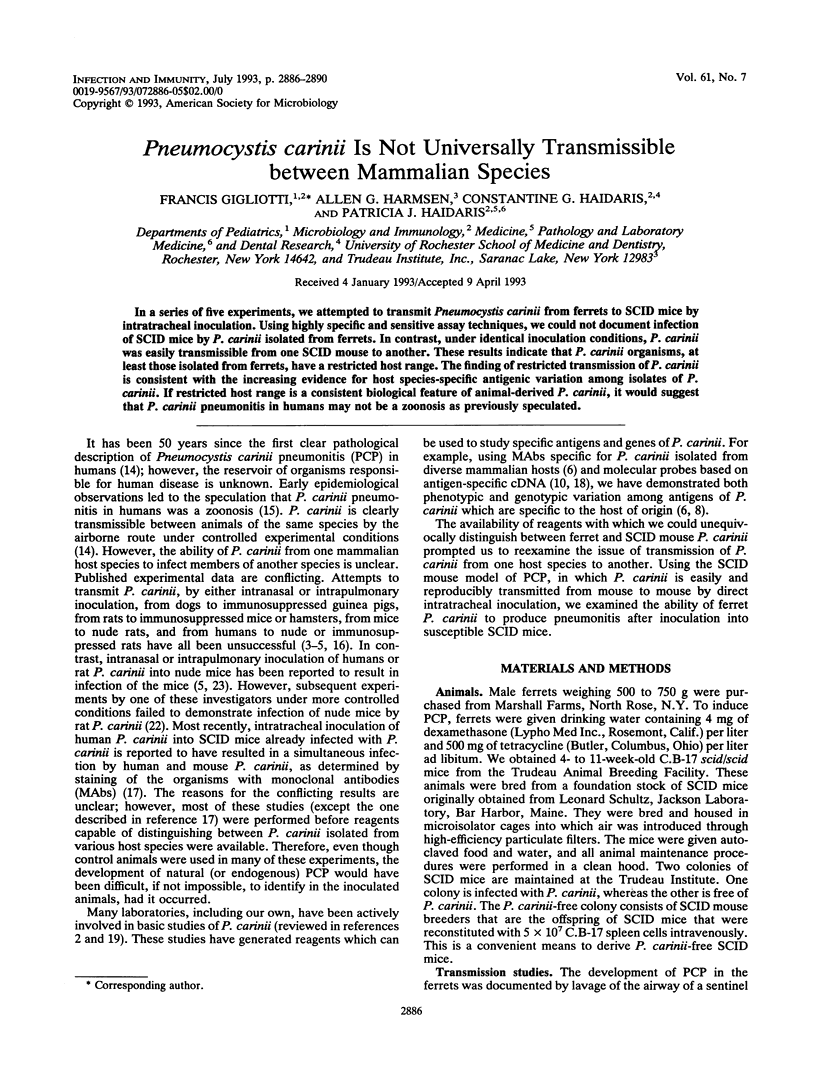
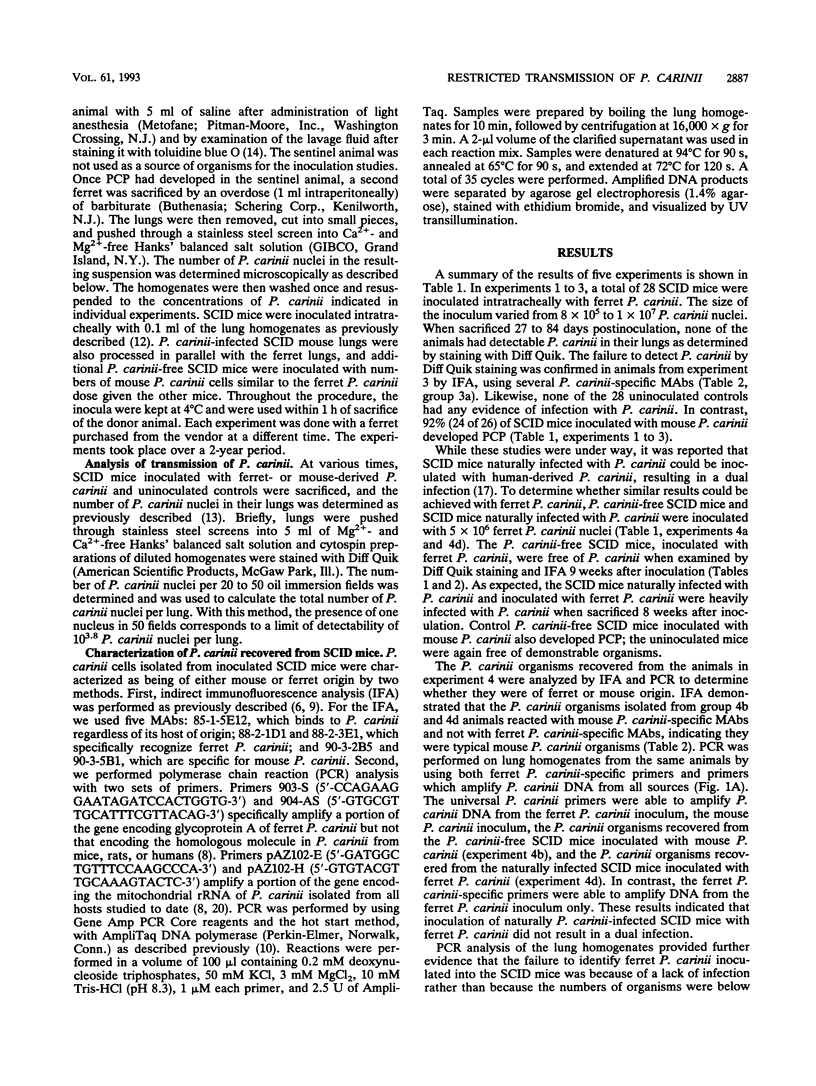
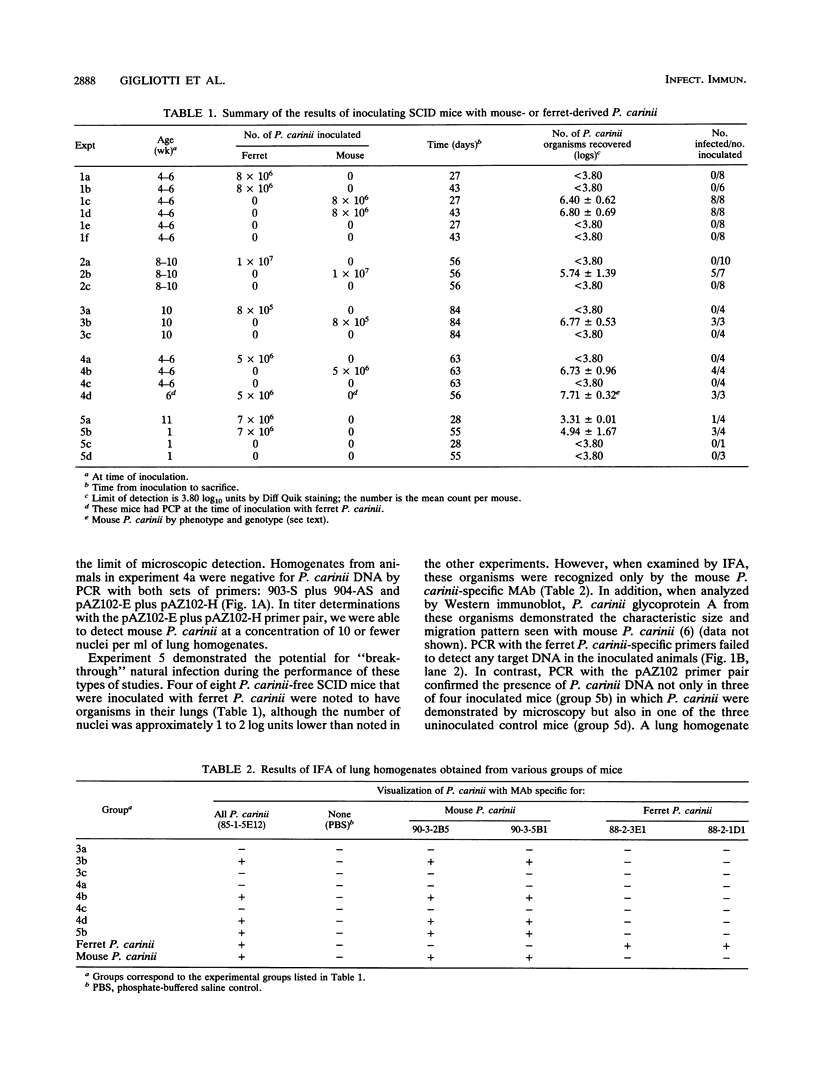
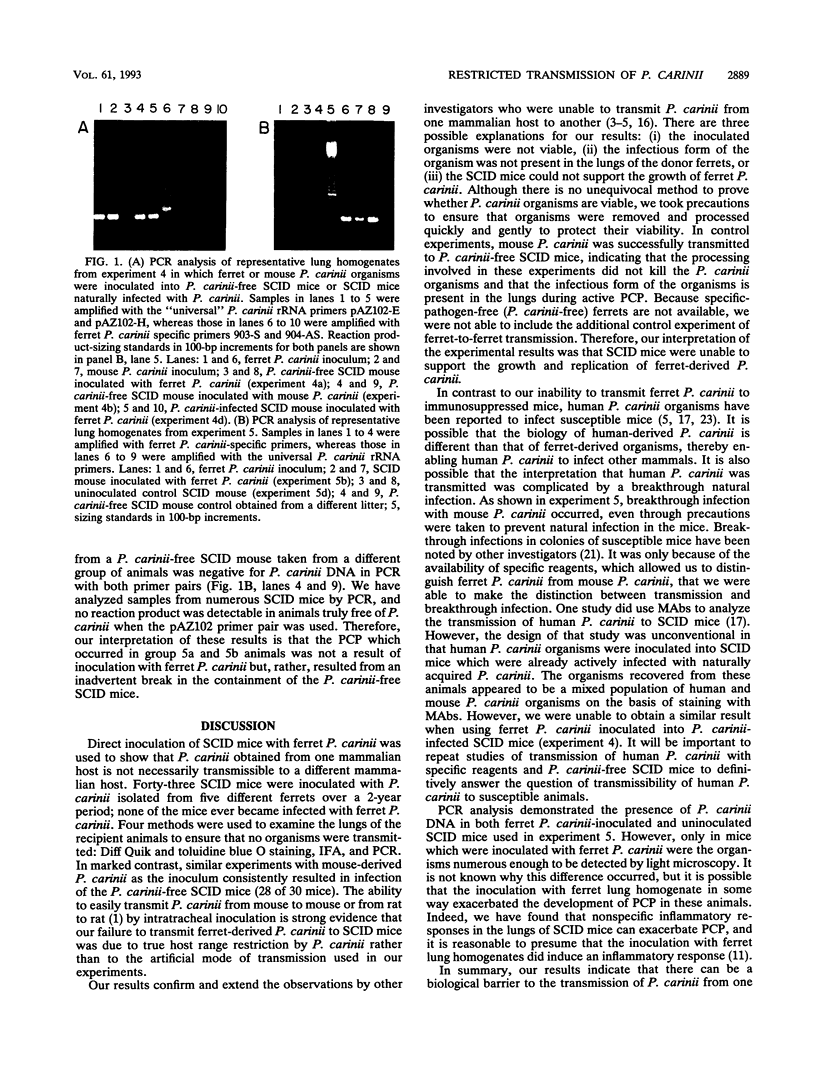
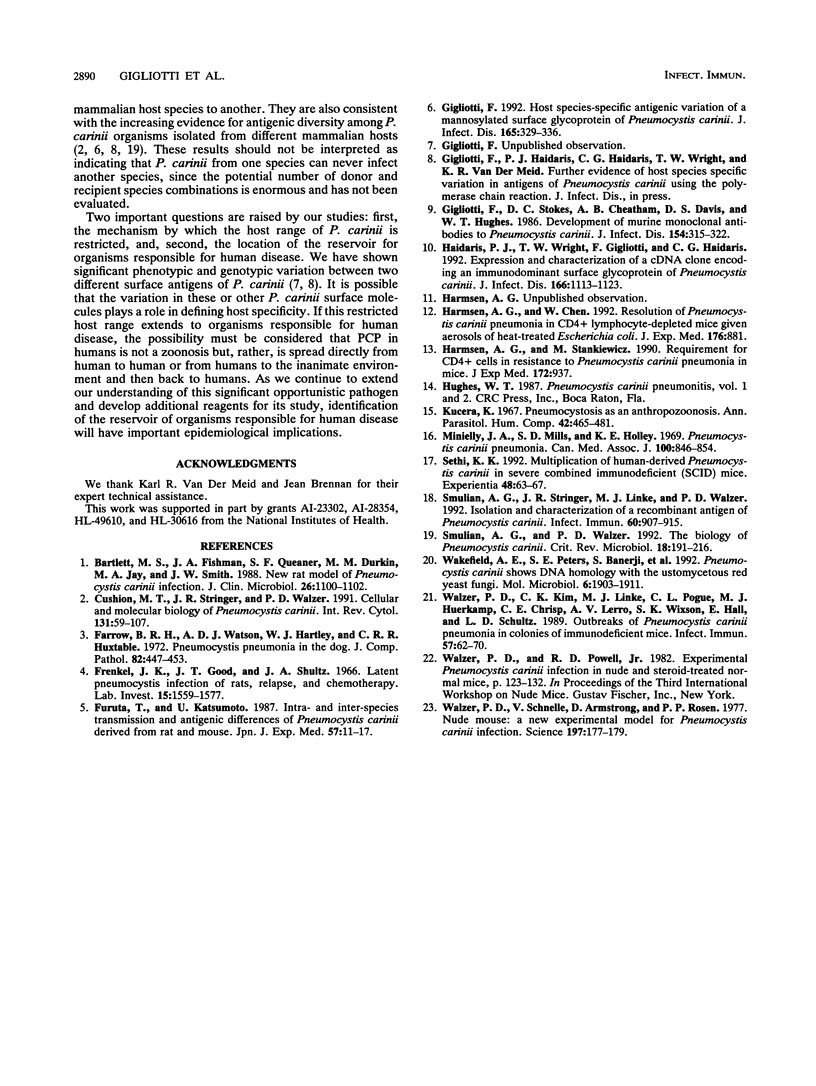
Images in this article
Selected References
These references are in PubMed. This may not be the complete list of references from this article.
- Bartlett M. S., Fishman J. A., Queener S. F., Durkin M. M., Jay M. A., Smith J. W. New rat model of Pneumocystis carinii infection. J Clin Microbiol. 1988 Jun;26(6):1100–1102. doi: 10.1128/jcm.26.6.1100-1102.1988. [DOI] [PMC free article] [PubMed] [Google Scholar]
- Cushion M. T., Stringer J. R., Walzer P. D. Cellular and molecular biology of Pneumocystis carinii. Int Rev Cytol. 1991;131:59–107. doi: 10.1016/s0074-7696(08)62017-3. [DOI] [PubMed] [Google Scholar]
- Farrow B. R., Watson A. D., Hartley W. J., Huxtable C. R. Pneumocystis pneumonia in the dog. J Comp Pathol. 1972 Oct;82(4):447–453. doi: 10.1016/0021-9975(72)90044-8. [DOI] [PubMed] [Google Scholar]
- Frenkel J. K., Good J. T., Shultz J. A. Latent Pneumocystis infection of rats, relapse, and chemotherapy. Lab Invest. 1966 Oct;15(10):1559–1577. [PubMed] [Google Scholar]
- Furuta T., Ueda K. Intra- and inter-species transmission and antigenic difference of Pneumocystis carinii derived from rat and mouse. Jpn J Exp Med. 1987 Feb;57(1):11–17. [PubMed] [Google Scholar]
- Gigliotti F. Host species-specific antigenic variation of a mannosylated surface glycoprotein of Pneumocystis carinii. J Infect Dis. 1992 Feb;165(2):329–336. doi: 10.1093/infdis/165.2.329. [DOI] [PubMed] [Google Scholar]
- Gigliotti F., Stokes D. C., Cheatham A. B., Davis D. S., Hughes W. T. Development of murine monoclonal antibodies to Pneumocystis carinii. J Infect Dis. 1986 Aug;154(2):315–322. doi: 10.1093/infdis/154.2.315. [DOI] [PubMed] [Google Scholar]
- Haidaris P. J., Wright T. W., Gigliotti F., Haidaris C. G. Expression and characterization of a cDNA clone encoding an immunodominant surface glycoprotein of Pneumocystis carinii. J Infect Dis. 1992 Nov;166(5):1113–1123. doi: 10.1093/infdis/166.5.1113. [DOI] [PubMed] [Google Scholar]
- Harmsen A. G., Chen W. Resolution of Pneumocystis carinii pneumonia in CD4+ lymphocyte-depleted mice given aerosols of heat-treated Escherichia coli. J Exp Med. 1992 Sep 1;176(3):881–886. doi: 10.1084/jem.176.3.881. [DOI] [PMC free article] [PubMed] [Google Scholar]
- Harmsen A. G., Stankiewicz M. Requirement for CD4+ cells in resistance to Pneumocystis carinii pneumonia in mice. J Exp Med. 1990 Sep 1;172(3):937–945. doi: 10.1084/jem.172.3.937. [DOI] [PMC free article] [PubMed] [Google Scholar]
- Kucera K. La pneumocystose en tant qu'anthropozoonose. Ann Parasitol Hum Comp. 1967 Sep-Oct;42(5):465–481. [PubMed] [Google Scholar]
- Minielly J. A., Mills S. D., Holley K. E. Pneumocystis carinii pneumonia. Can Med Assoc J. 1969 May 10;100(18):846–854. [PMC free article] [PubMed] [Google Scholar]
- Sethi K. K. Multiplication of human-derived Pneumocystis carinii in severe combined immunodeficient (SCID) mice. Experientia. 1992 Jan 15;48(1):63–66. doi: 10.1007/BF01923610. [DOI] [PubMed] [Google Scholar]
- Smulian A. G., Stringer J. R., Linke M. J., Walzer P. D. Isolation and characterization of a recombinant antigen of Pneumocystis carinii. Infect Immun. 1992 Mar;60(3):907–915. doi: 10.1128/iai.60.3.907-915.1992. [DOI] [PMC free article] [PubMed] [Google Scholar]
- Smulian A. G., Walzer P. D. The biology of Pneumocystis carinii. Crit Rev Microbiol. 1992;18(3):191–216. doi: 10.3109/10408419209114558. [DOI] [PubMed] [Google Scholar]
- Wakefield A. E., Peters S. E., Banerji S., Bridge P. D., Hall G. S., Hawksworth D. L., Guiver L. A., Allen A. G., Hopkin J. M. Pneumocystis carinii shows DNA homology with the ustomycetous red yeast fungi. Mol Microbiol. 1992 Jul;6(14):1903–1911. doi: 10.1111/j.1365-2958.1992.tb01363.x. [DOI] [PubMed] [Google Scholar]
- Walzer P. D., Kim C. K., Linke M. J., Pogue C. L., Huerkamp M. J., Chrisp C. E., Lerro A. V., Wixson S. K., Hall E., Shultz L. D. Outbreaks of Pneumocystis carinii pneumonia in colonies of immunodeficient mice. Infect Immun. 1989 Jan;57(1):62–70. doi: 10.1128/iai.57.1.62-70.1989. [DOI] [PMC free article] [PubMed] [Google Scholar]
- Walzer P. D., Schnelle V., Armstrong D., Rosen P. P. Nude mouse: a new experimental model for Pneumocystis carinii infection. Science. 1977 Jul 8;197(4299):177–179. doi: 10.1126/science.301657. [DOI] [PubMed] [Google Scholar]



